Breisgau and Kaiserstuhl - one of the most beautiful areas in Germany
Show Black Forest-Kaiserstuhl on a larger map
Winter in Kaiserstuhl - our new Video:
Breisgau, a picturesque district in south-western Germany, stretches from the Black Forest to the Rhine and offers a varied landscape of mountains, hills, lowlands, and water.
Its climate ranks among the warmest in Germany and that, together with the vineyards that line many hillsides, gives life something of a Mediterranean feel. Not only do grapes grow here; fruits (cherries, strawberries) and vegetables (asparagus) also flourish and in many gardens you can find peaches, apricots, almonds, and figs growing.
The cultural and economic centre of Breisgau is the university city of Freiburg (220,000 inhabitants). The university - founded in 1455 - is one of the oldest in Germany. However, Freiburg’s landmarks are its Gothic cathedral (Münster) and the picturesque medieval centre of the city with its narrow alleyways and brooklets, the typical Freiburg "Bächle". The Münster’s 116-meter spire has been praised as “the most beautiful spire in Christianity.”
The entire region of Breisgau has a high recreational value and enjoys an excellent reputation with visitors from Germany and other countries. The Rhine offers boat tours and river excursions, and numerous lakes provide swimming, boating, and other water sports. The Black Forest offers all kinds of winter sports and thermal spas for your health.
The highest peaks in Breisgau are Freiburg’s local mountain, the famous 1,284-metre Schauinsland (literally "Look out into the countryside") and the 1,241-metre Kandel, which is located near the town of Waldkirch. However, highest is not always best, and just as special are the group of hills known as the Kaiserstuhl (literally "the Emperor's chair"). They form probably the smallest mountain range in Germany with a diameter of not more than 15 to 20 kilometers - a distance that you can easily walk in a day on well-marked trails- and are completely different from the Black Forest. It is in Oberrotweil, one of the largest villages (well, we call it a town) nestling amongst these hills, that the Language Guesthouse is situated.
The Kaiserstuhl - a jewel of nature
Kaiserstuhl? If you hadn’t heard of it before, you aren’t alone. Nor have many of the guests who visit the Language Guesthouse for the first time. They ask for distances to Freiburg, to Colmar, Lake Constance, the Black Forest, Europa Park (all of which you can of course comfortably make a day-trip to from the Language Guesthouse), and many of them - coming here - are surprised of the scenic beauty of Kaiserstuhl’s hills. In many respects they are unique, having no match in Germany and maybe in Europe. This uniqueness starts with its origin and doesn't end with its inhabitants.....
Nevertheless the Kaiserstuhl does enjoy a reputation beyond its local borders: A reputation among connoisseurs, those who love it and return to visit time and again. - And connoisseurs are in this case by no means just those who only love Kaiserstuhl’s Burgundy wines.... You can walk or ride by bike nearly everywhere, usually on vineyard tracks which are often tarmaced but away from normal highway traffic (just watch out for the vintners on their mini-tractors). And meals out are not just the ‘typical’ sausage and sauerkraut: Breisgau has a distinctive cuisine to go with its fine wines and of course, being situated near France, Switzerland and Italy, many restaurants offer dishes with an international flavour.
But why ‘the Emperor’s chair’? No-one knows for sure but, according to Wikipedia, the name is believed to refer to King Otto III, who held court near Sasbach on 22 December 994. From then on, the whole hill range was called the Königsstuhl – the King’s Chair. In May 996, Otto III was crowned Emperor and the King’s Chair eventually became the Emperor’s Chair – "Kaiserstuhl". No reliable source mentions the name Kaiserstuhl before 1304 and historians thus suppose that the term Kaiserstuhl was not coined until the 13th century.
A journey back into earth’s history: geology and landscape in Kaiserstuhl
In geological terms the Kaiserstuhl is not that old: at the end of the Cretaceous period (about 65 million years ago) when the dinosaurs disappeared from the earth, there was no trace of it. Where today the Vosges and the Black Forest rise up on either side of the Rhine Rift Valley, there was just a more or less flat surface of clean layered sedimentary rock dating from the Jurassic period.
An overview of the various geological periods:

The formation of the Rhine Rift Valley, Black Forest and Vosges.
All that changed in the middle Eocene period, as tectonic forces in the earth's interior began to shape the earth’s surface in this region. Over a wide swathe of land extending in a north-northeast - south-southwest direction the earth’s surface began to sink and form a wide valley, while at the same time the rock masses to either side were pushed up. Between the ascending and descending masses of rock, the individual layers broke apart and were shifted against each other. The Jurassic rocks and the underlying rock strata slumped more than 1000 meters in depth in the Rhine Rift Valley and were raised more than 1000 metres on either side of it. Since these processes did not of course go entirely smoothly, numerous other smaller displacements of the layers against one other formed in the area (warping).
The first volcanoes in the Upper Rhine region
Such fractures and displacements are weak points in the Earth's crust, where liquid magma from the earth's core seeks a way out. This probably occurred for the first time in the Cretaceous Period (140-65 million years ago) and continued in the Eocene epoch (lasting from 56 to 33.9 million years ago) as small volcanoes formed at several points along such fractures. The Rhine Rift Valley gradually deepened and began to fill with water and great lakes formed. During the Oligocene epoch (extending from about 33.9 million to 23 million years before the present) there were even connections to the seas to the south and the north. The Rhine Rift Valley became an inland sea, where new deposits meant new sedimentary layers formed, while on the rising mountains of the Black Forest and the Vosges, the sediment layers were gradually worn away until the crystalline primary rocks of granite and gneiss were exposed at the surface. This erosion of sedimentary rock layers above the base rock was, incidentally, no trifling matter, as the layers were between 1000 and 1200 metres deep.
The sinking of the Rhine Rift Valley and the growth of the neighbouring mountain ranges has, by the way, still not ended and carries on at a rate of about one millimetre per year.
The origin of the Kaiserstuhl
Finally, in the Aquitanian stage of the Miocene epoch (starting about 23 million years ago) new tectonic forces changed the face of the region one more time: the northern part of the Rhine Rift Valley was initially covered with water, while in the south, deep within the earth, a magma bubble pushed up and began to raise the southern edge of the valley, including the mountains along its edge (the Black Forest and Vosges). The water disappeared, leaving a domed area whose centre lay in what is today the Kaiserstuhl. It formed a watershed: after the water had retreated even further north, the Rhine rose primarily to the north of this domed area, while to the south of it all the rivers flowed in a southerly direction. Only much later did the course of southern rivers changed and one of them, by uniting with the Rhine, made the fledgling Alps into the new European watershed.
At the end of the Aquitanian stage (about 20 million years ago) the magma eventually forced its way to the surface and formed the Kaiserstuhl volcano, which was to remain active for about 5 million years (until the end of the middle Miocene epoch). In this tectonically very turbulent time new cracks and distortions appeared in the sediment layers which had been deposited since the beginning of the formation of the Rhine Rift Valley and in the neighbouring mountain ranges. Water could penetrate through these cracks to form deep hydrothermal reservoirs, which visitors today enjoy as hot mineral springs in the Upper Rhine and the Black Forest, at, for example, the thermal baths in Freiburg, Bad Krozingen, in Badenweiler, Bad Bellingen, as well as in Menzenschwand and Bad Säckingen.
Kaiserstuhl’s volcano
What did the Kaiserstuhl volcano look like and what is left of it today? – Even someone with an untrained eye, looking at an aerial photograph of the central part of the Kaiserstuhl or perhaps viewing it from the hills near Vogelsang Pass, would have no difficulty in making out a group of volcanoes with clear craters in the shape of the range of hills, or the edge of a former crater in the horseshoe-shaped arrangement of the various slopes, but he would be mistaken. Today’s outcrops of volcanic rocks in the central Kaiserstuhl never saw the light of day during the volcano’s formation, nor while it was active. Instead they are formed of magma which somehow got "stuck" on its way to the surface and solidified deep inside the volcano.
While it was an active volcano, the Kaiserstuhl was certainly much higher - perhaps twice as high as today and definitely spread out over a more impressive area. It is perhaps best to think of its former shape less as a single conical mountain, but as a group of craters on a mountain upland. Volcanic rocks are still to be found beneath the surface a few miles south and southwest of the Kaiserstuhl, covered in the course of a few million years by river gravel deposits of the Rhine. Experts are remain divided as to whether the Breisach Münsterberg and Eckartsberg, which are also of volcanic origin, represent the remains of another former volcano or are remnants of a lava blanket which once reached from the Kaiserstuhl to Breisach.
Characteristics of the Kaiserstuhl volcano
15 million years of weathering and erosion has eaten away at the imperial grandeur of the Kaiserstuhl volcano. However, compared with other volcanic areas of Earth, the Kaiserstuhl had even then rather modest proportions and its activity, as measured by the lava "flow-rate", was far less than that of large volcanoes. Instead, its distinctiveness was and is not its size but its diversity - in every respect, even in the rocks and minerals that are to be found here.
The Kaiserstuhl was varied even in its activity, sometimes pouring liquid lava flows from its crater, sometimes spitting stones and ashes, then again- through the pressure of large amounts of escaping gas- hurling liquid or viscous lava high into the air, which froze into volcanic tufa filled with gas bubbles or roundish "lava bombs" before it hit the ground. A "versatile" volcano of this sort is called a stratovolcano - a type represented today by Etna in Sicily.
The magma, rising from a depth of 100 km, underwent on its way up to
the surface and after its discharge very distinct chemical and physical
changes that gave rise to the different volcanic products.
Lava which cools quickly has a fine crystalline (or possibly, where there
is very rapid cooling, even a non-crystalline, glassy) structure compared
with slow-cooling lava, where there is enough time for visible mineral
crystals to form. All these minerals do not crystallize at the same time,
but in a sequence which depends on the composition of the molten rock
in which they occur. As each component crystallizes, the composition of
the residual melt is changed. Therefore the volcano’s state at the time
of its eruption plays a decisive role in whether the lava flows out as
a basalt, a tephrite or a phonolite and which minerals it contains as
crystalline phenocrysts.
Other volcanic products formed when the rising magma made contact with
the surrounding sedimentary rock, wholly or partially melting the rock
in which, as it cooled, crystals also formed.
Many volcanic rocks underwent a further change owing to their sponge-like
structure. The cavities allowed for the crystallization of all sorts of
minerals whose beauty, however, is often revealed only under a magnifying
glass or a microscope.
The Kaiserstuhl volcano has long been recognised for its unusual variety of different rocks and minerals by professionals and interested lay people. Some of the rocks were identified for the first time here and given internationally recognized names that are reminders of their origin, for example, the Limburgit (named after Limberg nr Sasbach), the Bergalith (after Oberbergen) or Mondhaldeit (after Mondhalde which is located between Oberrotweil, Bischoffingen and Oberbergen).



Limburgit, with its hollows and crystals, found at the Limberg nr
Sasbach
The Kaiserstuhl volcano has still another geological feature to offer, which makes it almost unique in Europe: carbonatite, a rare basic igneous rock, which is characterized by a very specific composition (main mineral calcite, with a characteristic cocktail of secondary minerals including some rare earths) and which is otherwise found in Europe only in southern Norway and the Kola Peninsula in northwest Russia. Carbonatite forms the centre of the magma that cooled inside the vent of the volcano. It is one of the youngest igneous rocks of the Kaiserstuhl volcano and its current occurrence is mainly restricted to an approximately one square kilometer area of the central Kaiserstuhl, comprising essentially the Badberg, the Haselschacher Buck and the area as far as the Ohrberg at Schelingen. In peripheral areas of today's Kaiserstuhl (on Henkenberg between Oberrotweil and Burgheim and at Kirchberg in Niederrotweil) carbonatite tufa was discovered around 1980, whose drop-shaped or spherical composition suggested that they once were thrown there as liquid lava by an explosive eruption of the volcano.
Oh, before I forget: only about two-thirds of the Kaiserstuhl is of volcanic origin. The rock of the eastern third is formed by marine deposits laid down during the Tertiary Period (Oligocene Epoch). During the raising up of this area by magma pressing upward during the lower and middle Miocene epochs one section was raised higher than the rest and formed a hill, next to which in the middle Miocene Epoch the Kaiserstuhl volcano arose. Incidentally, the Tuniberg to the south of the Kaiserstuhl originated in a similar way: it, too, has its origin in a non-uniform raising of the height of individual areas of the Tertiary Period substrate.
And how did the volcano's story continue after it ceased to be active?
What else happened to the Kaiserstuhl and its surroundings before man appeared on the scene? Once it became extinct, erosion took its toll on the volcano over time and it was above all the ice ages and the warm periods between them which contributed to this process. The rivers, which by now had generally adopted their present courses, transported lots of boulders from the mountains (Alps, Black Forest, the Vosges and the Kaiserstuhl) into the still sinking Rhine Rift valley. And the wind blew the fine abrasive dust from their barren foothills, now left unprotected after the retreat of the glaciers, and from the river valleys to which the water had carried the dust and piled it wherever an obstacle presented itself, in the same way that snowdrifts occur in winter.
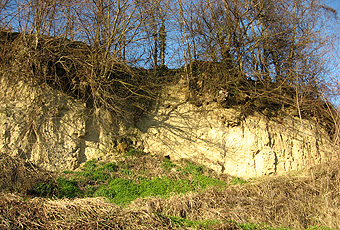
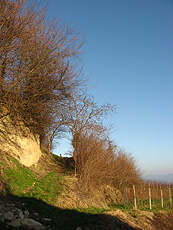 Loess
Loess
The Kaiserstuhl presented such an obstacle and thus acquired its mantle of loess, which was up to 40 metres thick in some places. Loess is referred to as "loose rock", which sounds paradoxical, but captures one of its main characteristics: loess is as soft and crumbly as well-weathered ground, but just like other stone, it only weathers on the top, where it is exposed to the elements; underneath it proves to be a sedimentary rock just like limestone or marl. And loess exhibits, despite its crumbling structure, a significant strength that we can observe in the Kaiserstuhl, especially in the ‘hollow ways’. There the loess, deposited by the wind, can form stable vertical walls10 metres in height. However, if the surface of the loess is worked or driven over by heavy vehicles, it loses the internal structure which gives it this stability and is easily washed away by rain. It is this characteristic which has resulted in some of the typical landscape features of the Kaiserstuhl, now to be found almost nowhere else in Germany.
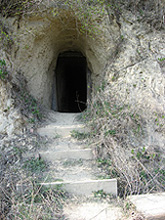
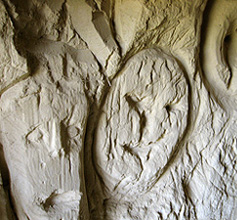
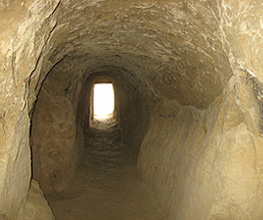
Loess: soft and stable at the same time / Loess tunnel near Eichstetten
Characteristics of the landscape
Terrace wine growing on loess ground
Typical above all of the Kaiserstuhl are the terraces on which the vines grow. Wine terraces were created in the Middle Ages, and not just in the Kaiserstuhl. But almost everywhere they have disappeared in favour of an easier workability of the soil by machine. In the Kaiserstuhl "machine-friendliness" was in the last century naturally also a debating point, but you cannot dispense with the terraces here without also exposing the fertile loess to soil erosion. Consequently in the 70s small terraces became large, sometimes very large ones. Erosion could thereby be substantially prevented, even if there were considerable landslides in some of the major terrace embankments after heavy rains. However, some other consequences of this transformation - on the microclimate of the terraced areas under cultivation, on the vegetation of the large terrace embankments and on the habitat of numerous small creatures typical of the Kaiserstuhl area - had not seen before. Today we try to take a middle course: big terraces are no longer created and the worst effects of the old ones have been eliminated by adjustments. However, the traditional small terraces, which sometimes had space for only 2 to 3 rows of vines, are no longer economically today and that could lead in future to these areas, which can only be worked by hand, lying fallow. This would mean that the Kaiserstuhl - with its old cultural landscape of terraces, small or large, and its many vines- would lose its familiar features and a portion of its diversity, and with it a number of Kaiserstühl winemakers their livelihood - maybe too the livelihoods of some that live from tourism here, for guests who love the Kaiserstuhl come here not only because of the sunshine but also because of the wine and its diversity of nature and scenery.
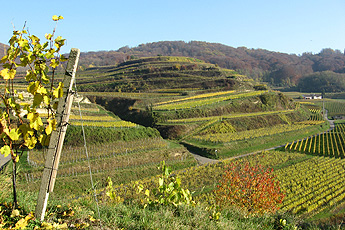
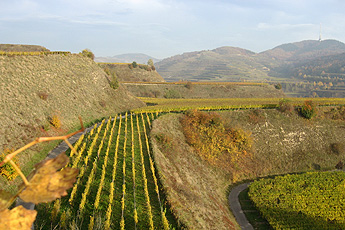
Wine cultivation on smaller terraces The big terraces were formed
in the Seventies
Small and large wine terraces, shown in the colours of October
Thus the realisation has dawned that the conflict between economics and ecology creates only losers on both sides and attempts at dialogue between conservation and viticulture have been made to find solutions that take into account the interests of both sides. The result of some newly designed terrace hillsides offers hope that these attempts can succeed. The complete "remodelling" of the landscape with the formation of large terraces in some areas of the Kaiserstuhl has incidentally also done some good: the impact on the flora and fauna, which has been studied scientifically from the start, has provided sometimes unexpected results and broadened our knowledge of how Nature appropriates new habitats.
Hollow lanes
In addition to its terraced vineyards the Kaiserstuhl has another typical cultural landscape feature to offer: the hollow ways or - as they are called here - Hohlgassen (‘hollow lanes’). They were –unlike the terraces- not created intentionally, but were formed accidentally in the course of at least a thousand years of land management. Because the loess lost its internal structure where carts were driven over it, it was washed away from the farm roads by the rain and in time, the ways became ever deeper: some carved 10 metres or more into the soft loess.


Typical Hollow Way near Bickensohl / neglected and partly filled-up
former hollow way near Ihringen
As late as the middle of the 20th century, the hollow road network in
the Kaiserstuhl was said to be like a maze, in which dogs were really
the only locals.
But in the course of land consolidation in the 70s and 80s, a large proportion
of these hollow ways were filled in, with no thought given to the many
animals to which they gave a home. The almost vertical walls of soft loess
rock are an ideal habitat for many animals: birds and mammals that make
their homes in holes use the tunnels made by thick dead plant roots as
a living space, while the local sand lizard and the European green lizard,
found in Germany only in a few areas with a Mediterranean climate, feel
at home here and also the smooth snake and the natterjack toad appreciate
the loess walls. Above all, they are a habitat for a wide variety of insects,
woodlice and spiders, which in turn provide a tasty prey represent for
the larger residents and visitors.
Wood and meadows
In the Kaiserstuhl everything has its place: grapes ripen on the sunshine-rich southern and western slopes; between the vines and the roadside almond trees grow and especially in early spring through their fragrant pink blossom fill all the senses with a feeling of spring; here and there one comes across a walnut tree. Cherry and other fruit trees are to be found in the valleys and on the less sun-drenched northern and north-eastern slopes.


Almond tree blossom in March (from Oberrotweil on the way to the lookout
point 'Mondhalde')
Natural vegetation holds sway on the slopes of the terraced vineyards, kept in check by mowing and the controlled burning-off of sections of the slopes in winter. One should not underestimate the extent of these slopes: they make up easily a third of the entire vineyard area and are a very effective semi-natural counterweight to the "monoculture" of the vines. And even these have not really been monocultures for quite a while now, because more and more winemakers allow wild herbs to grow under the rows of vines and in this way save themselves the need for intensive cultivation, a task the earthworms undertake instead, out of gratitude for the protection the undergrowth offers them.
Since quality-oriented wine-production no longer permits of vine planting above an altitude of 350 to 400 m, the higher areas remain the preserve of forest and meadow - varied mixed woods of drought-resistant tree species, covering many a hill like a cap, and meadows, which once were mowed by the farmers to provide winter feed for their animals. Today the management of these areas is directed towards conservation and the most striking meadows in the centre of the Kaiserstuhl - the Badberg and Haselschacher Buck - are in fact nature reserves, where today you can even find goats pastured to maintain the rare habitats.

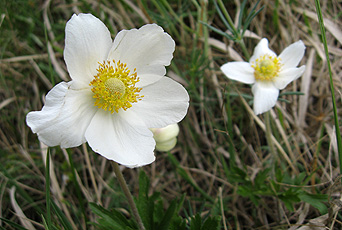
Signs of spring in the hills of the Kaiserstuhl: Grape hyacinth and
cinquefoil wood ("Kaiserstuhl") anemone (Anemone sylvestris)
Even so, whoever walks through the woods with his or her eyes open may chance upon a former terraced vineyard in the forest, a sign that not only quality but also quantity must have been the target of wine production in earlier times.
Flora and fauna in the Kaiserstuhl
Loess walls and their inhabitants
Among the insects to be found here are nearly 200 species of Hymenoptera, and a particularly large group of these is made up of the bees and bee-like insects (bees, wasps, etc.). The loess walls - especially if they are protected from rain – offer them an ideal place to nest and breed. Single live wild bee and wasp species each ensure in their own way that their offspring in the larval stage is well supplied with food by digging a little nest hole in the soft loess, then depositing a supply of food for their larva in it – in the case of wasps often a beetle larva, with bees, for example, a supply of pollen - and laying a few eggs there. Then they close the tiny nesting cavity thoroughly and leave the rest to Mother Nature. The hatched larvae feed on the food supply. When they have finally completed their metamorphosis, they free themselves from their nursery and leave a small hole in the loess. Those loess walls which are favoured by these insects are littered with such holes made by past generations, and while out on a ramble with a little patience you can also watch insects in the construction of new nests.


A loess wall with hatch-out holes of insects / Detail of the wall
showing a solitary bee
The loess walls are also of course popular as a breeding ground with the animals that live on these insects, especially the exotically-colourful bee-eater, which might be called the emblem of the Kaiserstuhl (were the Kaiserstuhl to have a coat of arms). The bee-eater appreciates the warm, dry climate of the Kaiserstuhl and otherwise nests in few places in Germany.
Bee-eater, the "heraldic animal" of the Kaiserstuhl
We do not know how long the bee-eater has made its home in the Kaiserstuhl, because its presence here is first attested only in 1877,when a bird-watcher noted that the birds, "who had settled a few years ago in the Kaiserstuhl hills in Baden", had not been observed that year. In 1876 there were reportedly 60 - 70 birds that made their homes in the loess hills in the area of Bickensohl but they were not here for long, because the human inhabitants of the Kaiserstuhl hunted them - whether because of the birds’ magnificent plumage or because of their weakness for bees on the menu is not reported.
Not until 1964 were bee-eaters attested as breeding in the Kaiserstuhl once more. Only individual observations and discoveries of the beautiful bird’s former breeding tunnels existed until 1990, after which the distribution and breeding of the bee-eater in the Kaiserstuhl was systematically recorded.
Today, the magnificent bird enjoys extensive care through conservation, and the tourism associations have recognized what a charming role it can play as advertising on their brochures. Now the bee-eater breeds throughout the Kaiserstuhl and the number of breeding pairs has increased from 7 in 1990 to 118 in 2007.
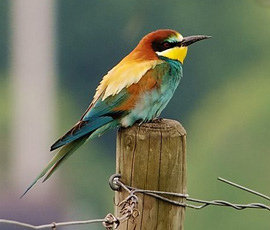 Bee-eater (photo:Wilfried Fiebig; source: Wikipedia)
Bee-eater (photo:Wilfried Fiebig; source: Wikipedia)
Anyone who wants to observe the bee-eater should take a pair of binoculars along and not expect to see the bird before Pentecost, because the bee-eater is a late returnee among the migratory birds. It uses the hot summer months for rearing its young and in September has already started its journey back to its winter quarters in tropical Africa.
What else does the Kaiserstuhl have to offer to nature lovers?
Although the bee-eater has the most spectacular plumage, it is far from the only "special" bird that is at home in the Kaiserstuhl. One should also make mention of the hoopoe – it is a magnificent sight with its reddish-brown plumage, its black and white striped wings and its attractive bonnet. In former times, when wine-production in the Kaiserstuhl was not so intensive, large fruit trees often stood between the terraced vineyards and the hoopoe nested in the hollows of old trees and other places where they found caves and niches.
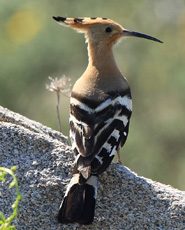 Hoopoe (photo:Arturo Nikolai; source: Wikipedia)
Hoopoe (photo:Arturo Nikolai; source: Wikipedia)
The fruit trees in the terraced vineyards are gone; orchards remain only on the valley floors and on slopes that do not get enough sun for growing grapes. As a result, there have been attempts to provide the hoopoe with new nesting opportunities: nesting boxes in the Rebhisli - the wooden huts that provide the vineyard workers with protection from the weather and where they can have their snacks - and the hoopoe has developed a taste for them. In 1993, 5 breeding pairs were documented as using the Rebhisli, in 2003 it was 32 pairs and by 2007 81 pairs. This is important, because in Central Europe the Hoopoe is on the Red List of endangered species and in 2005 only 380-450 breeding pairs were counted in the whole of Germany.
The hoopoe searches for food for its young in the bottom of the terraced vineyards. It particularly appreciates mole crickets, and if it cannot find enough of them is satisfied with beetle-grubs and field crickets. Despite its attractive appearance, the hoopoe has the reputation of being a " stinky bird ", a reputation it earns by its habit of defending itself by secreting a smell from its preening gland, which is seemingly not only offensive to the human nose.
The "typical" vineyard character is, however, the linnet, which breeds even amongst the vines. On the large terraces created at the end of the seventies his dominance was for years replaced by that of the tree pipit, which apparently got on better with the new landscape features. Only when the undergrowth of bushes gradually colonises the newly created embankments of the large terraces does the tree pipit retreat.
Of course, there are many other birds that make their home in the Kaiserstuhl, including those which are otherwise rare or very rare in Germany such as the wryneck, the little owl and the stonechat. Whether the sand martins have returned here that, much like the bee-eater, built their nests in loess walls until the mid-20th Century, I have not been able definitively to confirm. Only Baden-Württemberg’s Minister of Agriculture seemed to know as, during his speech at the award ceremony for the vineyard reorganisation on the Kirchberg at Schelingen, the Badische Zeitung quoted him as saying: "And in one of the most bio-diverse areas in the Kaiserstuhl new residents find a home alongside, for example, sand martins and cirl buntings." Was there just the one swallow which, as is well known, does not a summer make, sent flitting by a politician’s Sunday speech - or have the sand martins really come back?


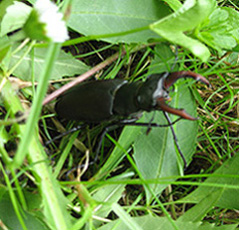
Kleiner Tatzenkäfer, leather run beetle and stag beetle, all of them
found on Kaiserstuhl walks
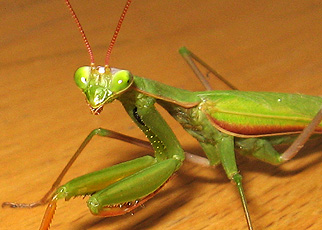

The praying mantis and the rose chafer came for a visit to my house
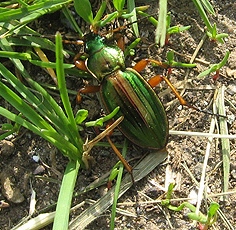
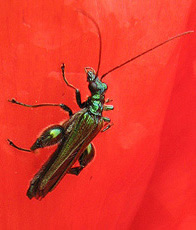

Krabbelt auf dem Kirschbaumpfad: Goldlaufkäfer/ Grüner Scheinbockkäfer
auf einer Mohn-Büte/ Holz-Schlufwespe* in meiner Küche
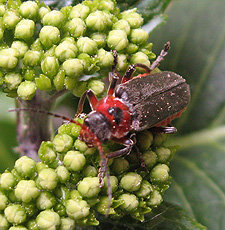
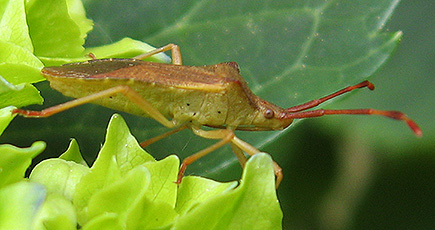
Eine Weichkäfer-Art (?) und eine Hasel-Randwanze auf einer Hortensie vor
dem Hauseingang



Und hier eine Zaunrüben-Sandbiene (noch nicht bestätigt) und eine Streifenwanze
* Ich kannte sie nicht und habe eine Anfrage gestellt im Forum von www.insektenfotos.de. Innerhalb von 10 Minuten bekam ich Antwort:
Hallo Anne, in Vogtsburg solltest Du interessante Insekten gewöhnt sein. Bei Deinem Besuch dürfte es sich um die Holz-Schlupfwespe Rhyssa persuasoria handeln. LG Volker Hohenberg.
Als Dank setze ich sofort einen Link auf dieses tolle Forum (siehe unten)
Hier noch einige flatterhafte Kaiserstuhl-Bewohner:


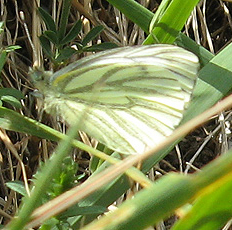
Der Heidespanner verschlief den Tag an der Hauswand /Das Große Ochsenauge
stammt vom Badberg / Grünader-Weißling...

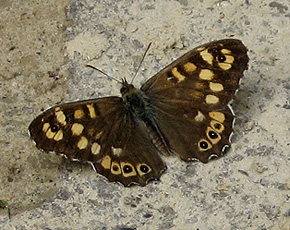
Tagpfauenauge und Waldbrettspiel-Falter: alle drei vom Löss-Hohlwegepfad
bei Bickensohl
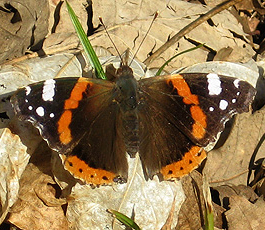

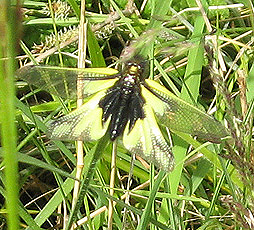
Admiral /Großer Johanniskrautspanner /Libellen-Schmetterlingshaft:
ebenfalls vom Löss-Hohlwegepfad.
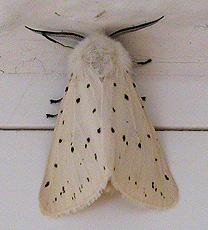

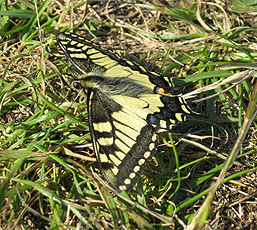
Der Breitflügelige Fleckleibbär hat mich in meiner Wohnung besucht / der
Schwalbenschwanz flatterte auf dem Badberg
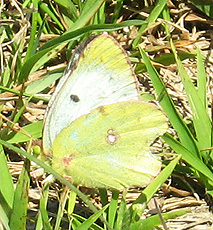
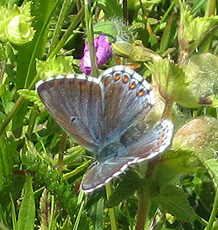

Eine Goldene Acht, Himmelblauer Bläuling (♀ und ♂)
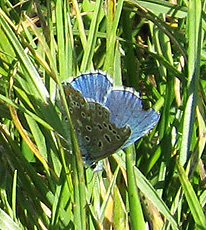
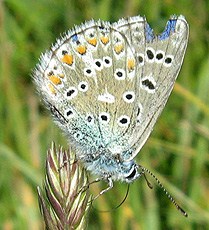
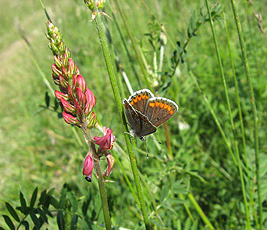
Himmelblauer Bläuling (Flügel-Unterseite), Kleiner oder großer
(?) Sonnenröschen-Bläuling
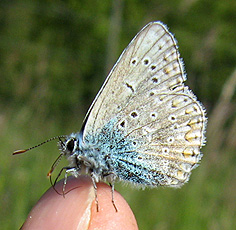

Hauhechel-Bläuling (vermutl.), die letzeren alle von den Halbtrockenrasen
des inneren Kaiserstuhls
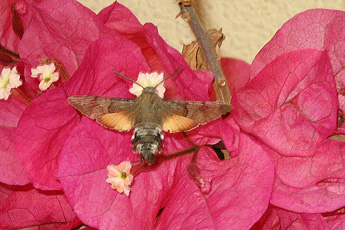
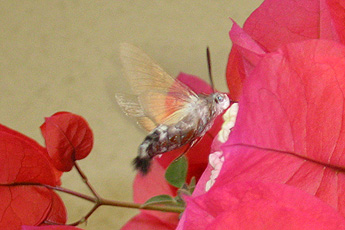
Noch ein Balkon-Gast: Das Taubenschwänzchen schwirrt wie ein Kolibri,
während es die Blüten der Bougainvillea besucht
Among experts, the Kaiserstuhl enjoys its reputation not only because of its bird-life but also because of its abundance of habitats with rare communities of plants and animals which can (still) be found here, such as the dry and semi-dry grasslands on the hills of central Kaiserstuhl which, because of their calcareous subsoil, are unbelievably colourful and rich in flowers in May and June. However, older residents can remember that 50 years ago such colourful meadows were not uncommon in southern Germany, and were a feature of many rural villages. On such sites orchids and butterflies are to be found which will delight any walker when he happens upon them, but some of the rarities from the plant and animal kingdoms are rather inconspicuous or belong to classes of animals for which many people cannot easily work up an enthusiasm, such as, for example, spiders, crickets or snails ... The Kaiserstuhl is also well-known because its particularly warm climate has led to a number of plants and animals finding a home here which are actually more at home in the Mediterranean. This applies to the bee-eater, but also to the green lizard, the praying mantis, the downy oak, the burning bush plant and a number of others that have either been resident here for a long time or have only recently ventured north.


Green lizard-Männchen mit himmelblauer Kehle und ein Weibchen
* In Wikipedia wird aufgrund genetischer Vergleiche die Kaiserstuhl-Population der Östlichen Smaragdeidechse (L. viridis) zugerechnet. Ich beziehe mich hier auf die Quelle 1 (Thorbecke: Der Kaiserstuhl), die die bisher anerkannte Zuordnung wiedergibt.
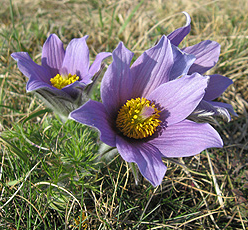

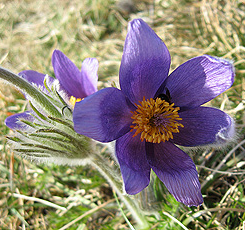
Läuten den Frühling ein: Pasqueflower seen on the Badberg in the central
Kaiserstuhl
Und jetzt noch weitere botanische Schönheiten aus unserer Gegend:
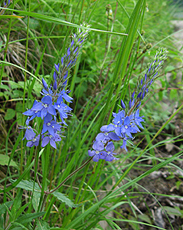
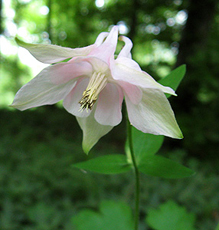

Großer Ehrenpreis /Gewöhnliche Akelei /Echter Baldrian


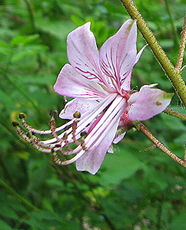
Blut-Storchschnabel/ Diptam / Diptam-Einzelblüte

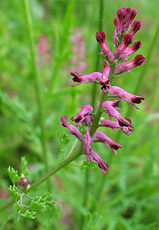

Dolden-Milchstern / Gewöhnlicher Erdrauch / Karthäusernelke

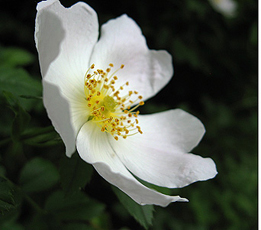
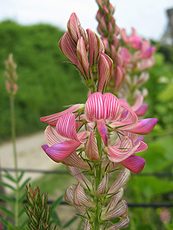
Großer Bocksbart /Hundsrose /Futter-Esparsette
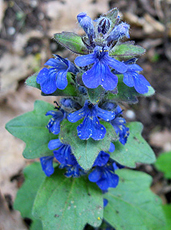

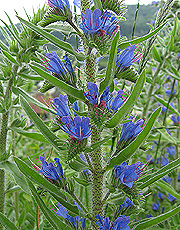

Kriechender Günsel/ Maiglöckchen / Blauer Natternkopf /Wald-Knäuelgras



Nickendes Leimkraut / Rapunzel-Glockenblume / Scharfer Hahnenfuß
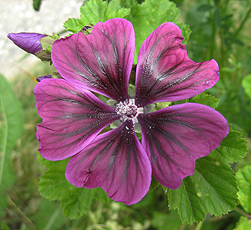


Wilde Malve / Weiße Lichtnelke /Zaunrübe
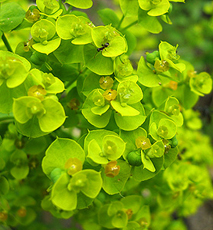
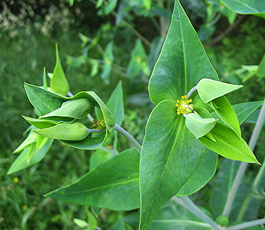

Zypressen-Wolfsmilch / eine mir unbekannte Wolfsmilch / Stauden-Lein
If you want to know more about Nature in the Kaiserstuhl, its typical characteristics and the rarities that bloom or creep in secret, I would recommend that you join in one of the excursions arranged by the Ihringen Nature Centre. These excursions are leaded by authorities on the Badberg and the Büchsenberg, Liliental and Limberg and they will help you to get to know both what is typical and what is special about the habitats in the Kaiserstuhl. And once its fascination has grabbed you, I’m prepared to bet you will keep coming back!
Sources:
Der Kaiserstuhl - Einzigartige Löss- und Vulkanlandschaft am Oberrhein,
Autorengemeinschaft Rainer Groschopf u.a. Hrsg. Regierungspräsidium Freiburg,
Jan Thorbecke-Verlag 2009
Wikipedia
PLENUM - what's that?
In the Kaiserstuhl it was resolved - after some ecological sins, especially in the sixties and seventies of the last century, and in response to continuing protests - to try to reach an understanding amongst the differing interests of the local farmers and vine-growers, of the businesses that live from tourism and their guests, of the local population and its regional economic structures for trade and commerce that do not belong to any of the above groups, and of the towns and villages in the Kaiserstuhl, at the same time recognising the needs of nature conservation and the clubs and associations organized to support it.
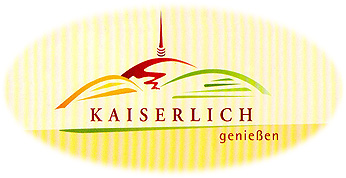 One
of the most important steps in this direction was to create a structure
in which it was possible, with the participation of all stakeholders and
interested parties, to discuss the issues, make decisions and implement
change. It was also necessary to secure the financing of the measures
to be adopted, something which was facilitated by participation in a programme
set up the State of Baden-Württemberg for support of rural areas in close
cooperation with the local population. The programme has the name PLENUM
(in German, "Projekt des Landes
Baden-Württemberg zur Erhaltung und Entwicklung von Natur
und Umwelt")
One
of the most important steps in this direction was to create a structure
in which it was possible, with the participation of all stakeholders and
interested parties, to discuss the issues, make decisions and implement
change. It was also necessary to secure the financing of the measures
to be adopted, something which was facilitated by participation in a programme
set up the State of Baden-Württemberg for support of rural areas in close
cooperation with the local population. The programme has the name PLENUM
(in German, "Projekt des Landes
Baden-Württemberg zur Erhaltung und Entwicklung von Natur
und Umwelt")
The partners in Kaiserlich genießen quality-mark scheme have committed themselves to actively strengthening the regional economy and to supporting the development of a regional producer-consumer cooperative partnership. All contribute their share to the preservation of the unique natural environment of the Kaiserstuhl by, for example, either farming 10 percent of their land extensively rather than intensively or managing it in accordance with the requirements of nature conservation. If you see a product with the Kaiserlich genießen quality-mark, you know that it comes from a partner in the scheme. It is made in accordance the guidelines which all the scheme partners, along the entire production chain, have undertaken to respect.
This programme makes available to the various regions that participate in it resources of the state of Baden-Württemberg, from which the individual projects launched there in accordance with the project’s overall objectives benefit . In July 2002, the Kaiserstuhl was included in the PLENUM funding. The district council has approved the participation of the region and set up an office in the district office with 3 employees for coordination tasks (the PLENUM team). The State Institute for Environmental Protection (in coordination with the Ministry of Food and Rural Affairs) provides technical assistance and monitors the success of individual projects. A Project Advisory Committee consisting of representatives of the various interest groups named above has been formed, which discusses and reviews project applications and makes recommendations. Projects can be initiated by virtually any individual in the Kaiserstuhl - as well by clubs, associations, businesspeople and schools - and a request made for financial assistance to be provided by PLENUM . Provided the target and the planned implementation meet the aims and objectives of PLENUM to the satisfaction of the PLENUM professionals and project advisory board, a project will have a chance of receiving funding. For the implementation of individual projects, working groups can be formed and the projects / working groups will be advised by the PLENUM team.
From the very start of the Kaiserstuhl region’s involvement in the PLENUM scheme a number of remarkable individual projects have been realized under its "umbrella "and more are in the pipeline or in the planning stage. I am writing this here because I think it is important that guests who visit our region learn about PLENUM, its aims and how it works, because wherever they go in the Kaiserstuhl, they will sooner or later encounter the informative green signs on walking trails which point out features of note, provide historical references or give interesting facts about animals and plants,
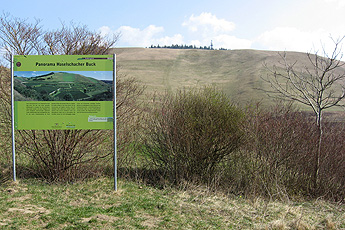

Info board on the theme trail "Badbergweg"
vineyards and orchards and the natural and cultural landscape of the Kaiserstuhl. When shopping they will encounter products with the regional quality-mark brand "Kaiserlich genießen" of the producers’ group "Naturgarten Kaiserstuhl"- all things that would not exist without PLENUM. And because everyone plays a part in PLENUM, it stands for a nature-friendly local economy and sustainable tourism. The stakeholders in PLENUM projects are aware that nature, rural economy and tourism are so closely intertwined here that each is dependent on the others for survival.
Hiking trails across the Kaiserstuhl hills
One of the most successful PLENUM projects has been the creation of a well thought-out and planned network of numerous paths that open up the Kaiserstuhl for walkers and hikers and make it possible to access and observe its natural beauty, its plant and animal life, its scenic spots and features of its cultural landscape.
 Sign post with blue banner: The Wild Orchid path
Sign post with blue banner: The Wild Orchid path
These trails have names that are derived from their main subject of interest, and so are named after animals or plants that are particularly likely to be met with on the route, such as the Hoopoe Trail or the Wild Orchid Path, or after prominent features in the landscape which a trail passes, like the Nine Linden Trail, which is named after a local viewpoint, the Nine Linden Tower, or Catherine's Path, which is named after St. Catherine's Chapel. Eight such "themed" trails or paths, running in different directions, criss-cross the Kaiserstuhl, while others are designed as circular routes, starting from a town or village and returning there again . So all the paths are unique and each of them is worth following - several times in fact, and at different seasons. I am a keen walker myself, and will introduce you to one or two paths at this point, giving my completely personal impression of them, and with pictures I took as I walked.
On the way along the Wild Orchid Path
On a sunny Sunday in mid-May 2012, I string up my hiking boots, pack a small daypack with two sandwiches, a bottle of water and 3 apples, my Kaiserstuhl walking map, a notebook with writing materials, and of course my little digicamera, and start off to get to know the wild orchids of the Kaiserstuhl. My route begins in Bötzingen, and I get there on the 295 bus. Even the bus ride over to Vogelsang Pass is a pleasure, because spring is showing itself in the green foliage and spring flowers, which catch my eye.
In the middle of Bötzingen a classic car show with all kinds of stalls is taking place. Many families in colourful summer clothes stroll through the streets to admire the wonderfully restored, freshly painted veteran cars with their glinting bright chrome trim and to revel in car nostalgia. I too mooch along the road, but don’t allow myself to dawdle too long before I turn my back on Bötzingen and start the ascent to Vogelsang Pass. On the way there is an opportunity to take a look back at the town and to snap a photo with bright poppy flowers in the foreground.


From Bötzingen up to the Vogelsang pass with flowering wild roses
and poppys
Always on the look-out for interesting little things along the way, I walk up the hill past dandelion clocks and fragrant elder bushes. Oh, it's time to pick elderflowers to make elderflower cordial. My guests enjoy it as a welcome drink, mixed with mineral water. It smells and tastes deliciously of summer and is almost always good. I will also have a go at making some elderflower jelly for the breakfast table. I discover an insect on an elderflower - which on first glance looks like a wasp to the untrained eye, but no ordinary one with the interesting striping on the abdomen. Or is it a wild bee? No, not really. Maybe even a fly that has disguised itself in a dangerous-looking "costume"? Too bad that I’m not so good at identifying insects! Here are two photos! Please contact me if you know the name of the little creature!



Does anyone know this little animal? /Dandelion blowballs
Of course, the vines are my constant companions. And here - thanks to the willingness of the Bötzingen wine-growers to offer information - no question regarding the vines remains unanswered: "The White Burgundy grape, like the Pinot Grigio, demands exacting standards of site and soil. It produces very elegant, spicy wines of pronounced acidity and stimulating harmony.’’ ‘‘The Bötzingen Pinot Blanc Spätlese or Auslese with its variety of exotic fruit flavours provides a wonderful taste experience." You can read almost poetic lines like these, in the middle of the countryside, on the plain white noticeboards here. Or how about this on the Chardonnay: "these wines impress with their great complexity through an abundance of vanilla and coffee aromas." I'm always fascinated by the flowery language of wine experts. Such descriptions capture the imagination. Although - I'm not quite sure my perception of a wine’s bouquet has much in common with what’s really there. Maybe I should take part in a wine tasting in Bötzingen to sort this out...
Now I pass the Bötzingen quarry. Previously, there were several quarries in the Kaiserstuhl. This is the last one still in operation: phonolite, a volcanic rock that produces a strikingly bright tone when struck, is mined here. The uses of the mineral are extremely varied and include such diverse applications as "cement", "environmental technology in waste incineration plants", "production of animal feed", "natural mud and filler in medicines", "glass making". An exhaustive answer is provided by the State Agency for Geology, Raw Materials and Mining.
The higher the path leads me, the greater the extent of the views. Here is a picture with the quarry in the middle of the picture and the Black Forest mountains in the background:


View across the quarry of Bötzingen / Path to the Vogelsang pass
Soon I have reached the edge of the forest and my path crosses the road leading from Bötzingen to Vogtsburg, which connects the southeastern Kaiserstuhl with the western part. From now on, the trail leads through sparse deciduous forest and, a few minutes later, I'm at the only pass *) in the Kaiserstuhl, which, although it does not have the grandeur of the high alpine passes, is still an important crossing point at which different routes meet, namely the Wild Orchid and the Nine Linden trails and the road from Bötzingen to Vogtsburg.
*) Sorrry, this is an error, because there is another pass, the so called "texas pass" between the villages Oberbergen and Kiechlinsbergen
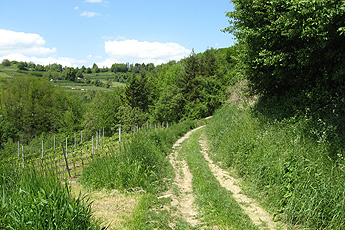

Up to the Vogelsang pass / Meadow clary flowers visited by a bumble
bee
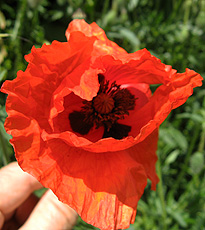
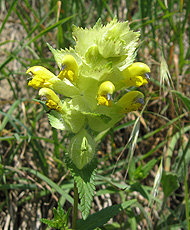

Flowery treasures along the path: Red poppy and yellow rattle
The Nine Linden trail leads in a westerly direction straight to Totenkopf hill with the Nine Linden tower - the highest point in the Kaiserstuhl, and impossible to miss even from a distance because of the striking transmission mast on its top. The trail goes in a northerly direction towards the second highest summit in Kaiserstuhl, the Eichelspitze, with its modern pinnacle as a lookout point. But I’m not being a mountaineer today. My route has Liliental as its goal with its old estate, which now houses a botanical experiment and breeding research station and the Arboretum (a sort of botanical garden for trees) belonging to the Forest Research Institute in Freiburg. It was home at the end of the 19th and in the early 20th century to an important trotting horse stud. The grazing by horses and the long tradition of hay-mowing is the explanation given today, at least in part, for the abundance of various native orchid species in the grounds of Liliental. From April to June they are a magnet for visitors and also attract me there today.
But I’ve not got to the Liliental yet. Before then I have in front of me a nice walk in the woods beside the gently-sloping terrain of the Gagenhardt, a wooded ridge with magnificent beech trees, but where terracing can still clearly be seen - a sign that in earlier times there was no forest here: instead the land was used for agriculture.
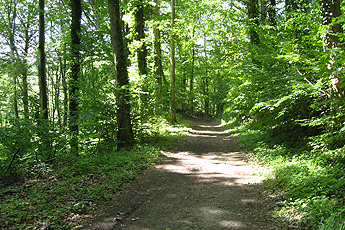


Gagenhardt forest with lily of the valley and spiked rampion.....
With a little imagination, it is not difficult to discover bizarre forest
spirits and funny root figures here and there:
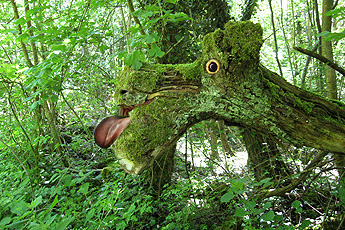

....some spirits of the forest (I helped along a bit for the less
fanciful hikers...)
Not long and I reach the estate’s lower fish pond and then the Liliental itself. The estate has experienced a history of varying agricultural uses and multiple changes of ownership. Since the 50s and 60s of the last century, it has been owned by the State of Baden-Württemberg and housed the Arboretum with its native and exotic trees, as well as trial plots for various woody plants that are tested here in long-term studies for their habitat requirements, growth characteristics, and so on. Information boards tell hikers about the objectives of the experiments. What’s more, in the restaurant "Zur Lilie" the walker can satisfy his hunger and thirst before or after a tour of the extensive grounds.

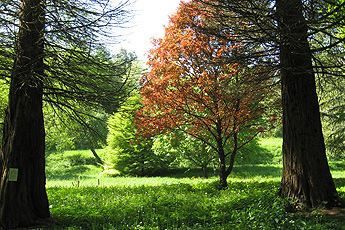
"The Lily" inn (the photo was taken earlier in the year)
and some impressions of the Arboretum


The Arboretum / Here with "vine" terraces

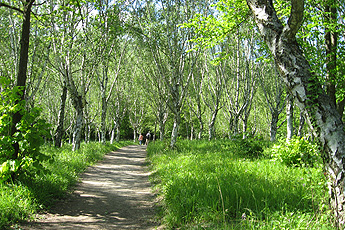
Experimantal area: Ice resistant birch trees and texture birches

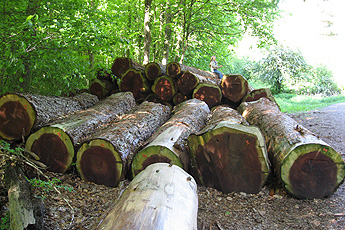
Wood of redwood trees /Redwood tree logs
A tour of the Arboretum and the experimental plots gives rise to a fascinating variety of impressions. First of all there is the botanical park with a variety of individual trees (including the impressive primaeval redwood, which for a long time was known only from fossil finds and therefore thought to be extinct, until live specimens were discovered in Korea), then copses each made up of a single clone tree (vegetatively propagated), such as the or ice (resistant) birch and the curly birch: both belong to the same species (the silver birch Betula pendula) as native birch species, but their growing habits are different: one has straight, slim, tall stems, the other forms diminutive trees with many branches. One day their wood will be processed into high-quality veneer. In the case of the burl birch, the main selection criterion was its habit of frequent branching. The goal is to have a tree which provides a particularly beautiful burl veneer. The forest of redwoods makes a completely different impression. With their towering trunks they seem after a just few decades to be trees for eternity. And that's not so fanciful. In America, individual specimens have been found that are up to 3000 years old. One could wish in our fast-paced age that the Sequoias in Liliental attain at least one-tenth of that long lifespan.
Oh yes, and now of course the orchids. I've left plenty of time to find, look at and photograph as many as possible. Here are my best photos:
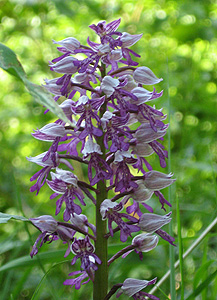
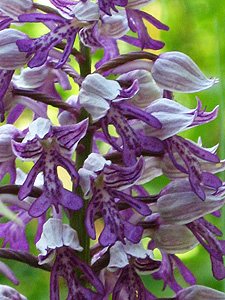
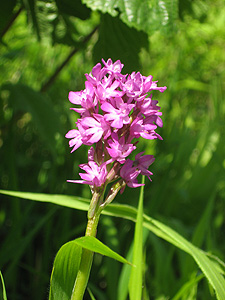
Military Orchid (Orchis militaris) in close-up / Pyramid Orchid (Anacamptis
pyramidalis)

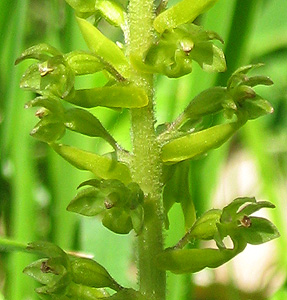
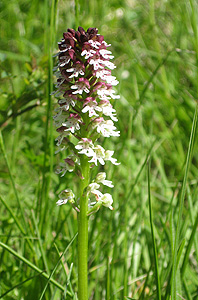
Greater twayblade (Listera ovata) in close-up / Dwarf orchid (Orchis
ustulata)
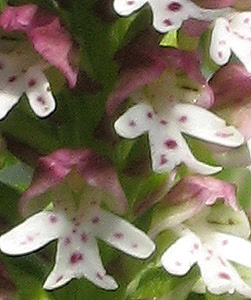


Dwarf orchid (close-up view) / Bird's nest orchid (Neottia nidus-avis)
in close-up

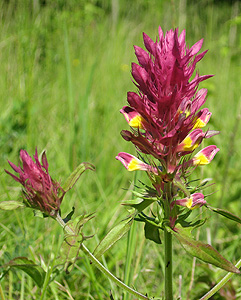
Sword leaved helleborine (Cephalanthera longifolia) / Purple cow wheat
(Melampyrum arvense), the latter isn’t an orchid.
The last of these plants was in my childhood an ordinary arable weeds in the crop fields. Now you can’t find it there any more, so here is a portrait of it as a special feature of the Liliental.
Having spent at least 3 hours in the Liliental, I make my way home to Oberrotweil. The Wild Orchid trail continues through the Wetzental past the Straußenwirtschaft (a small vine tavern, attached to a vineyard, licensed to open not longer than 16 weeks per year)"Martinhöfe" to the guest house "Lenzenberg", then makes another wide arc over the Kreuzenbuck, the Blankenhornberg and the Winklerberg hills, continues for a further stretch through the Rhine Valley and finally ends at the train station in Breisach. However, I have left the path shortly after the Liliental, have rambled over the Adlerhorstsattel ridge towards Bickensohl, following the Lösshohlwege path for a while, to finally return to Oberrotweil in the evening sunlight. Here are a few shots I took on the way back:
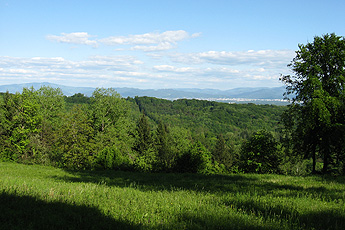

View in the direction of Freiburg - in the background the Black Forest/
Greater periwinkle (Vinca major)

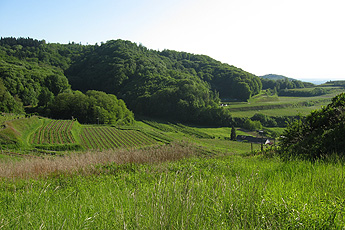
Hollow way in the woods/ Kaiserstuhl scenery near Bickensohl
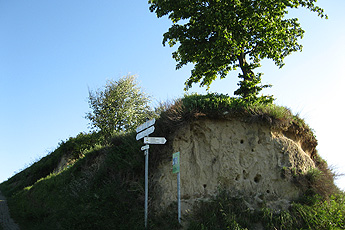

Loess quoin at a road crossing / View of the Totenkopf


Hollow way with view of Oberrotweil / Kaiserstuhl anemone (Anemone
sylvestris)
Looking for the Spring: along the Cherry tree path
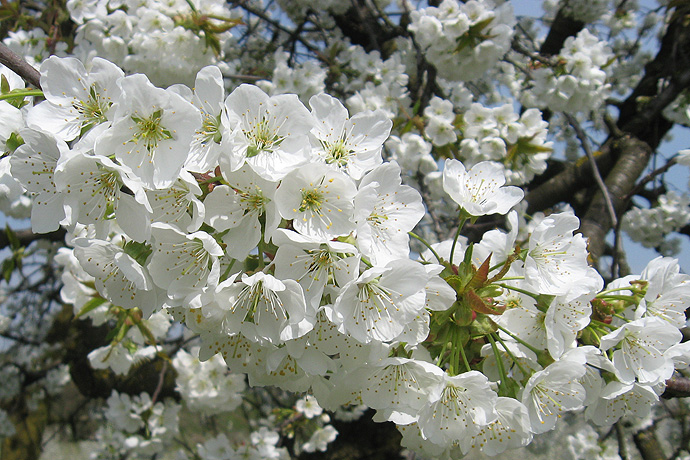
Beim zweiten Versuch bleiben keine Wünsche offen:Kirschbaum in voller
Blüte
Im vergangenen Jahr (2013) ließ der Frühling lange auf sich warten - in ganz Mitteleuropa und auch im Kaiserstuhl. In anderen Jahren beschert uns schon der März blühende Mandel- und Kirschbäume, doch voriges Jahr kam die Sonne nur mal zu einer Stippvisite vorbei, sonst blieb es kalt und nass. Deshalb war es schon fast Mitte April, als endlich ein richtig warmes Wochenende nach draußen lockte und ich mich auf den Weg machte um den Frühling zu suchen. Und welcher Weg könnte dafür wohl besser geeignet sein als der Kirschbaumpfad, der am Nordrand des Kaiserstuhlgebirges entlang von Sasbach über die hübschen Orte Leiselheim, Kiechlinsbergen, Amoltern in das alte Städtchen Endingen und weiter bis nach Riegel verläuft, mitten duch das Kaiserstühler Kirschanbaugebiet?

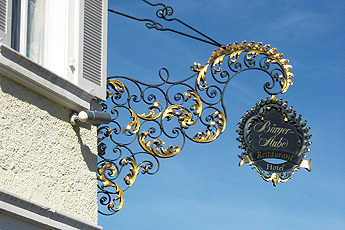
Bahnhof Oberrotweil: Das Kaiserstuhl-Bähnle kommt /dieses schöne Wirtshausschild
findet man in Sasbach
Von Oberrotweil aus ging es erst einmal mit der Kaiserstuhlbahn nach Sasbach. Der Kirschbaumpfad beginnt eigentlich schon auf dem Limberg, einem vulkanischen Ableger des Kaiserstuhls direkt am Rhein. Der ist natürlich auch einen Besuch wert, doch nicht in erster Linie wegen der Kirschbäume. - Ich startete also von Sasbach aus gleich in Richtung Leiselheim. Als erstes klettert der Weg mit dem kirschenroten Balken auf den Wegweisern - Weinberge rechts und links - auf einen Hügel namens Eichert. Von dort hat man eine weite Sicht in die Rheinebene. In der Ferne kann man die Achterbahnen des Europaparks entdecken und bei klarem Wetter sogar den Turm des Straßburger Münsters.
Das Wandern im Sonnenschein bei strahlend blauem Himmel ist ein Genuss. Das Fliegen in der blauen Frühlingsluft muss es auch sein, die Lerche dort oben trillert und jubiliert die ganze Zeit, als wollte sie aller Welt verkünden, wie glücklich sie über diesen wunderbaren Sonnentag ist. Auf den Wiesen und unter den Weinreben zeigt sich erstes Grün und auch schon einige wilde Blumen, Knospen schwellen und hier und da blüht auch schon ein Strauch, doch die Kirschbäume - das wird sehr schnell offenbar - warten noch auf weitere warme Tage.
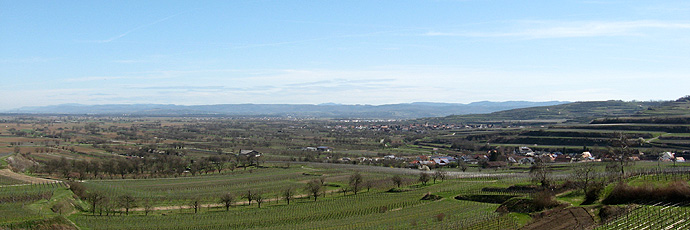
Von den Hügeln des nördlichen Kaiserstuhl hat man einen weiten Blick,
doch nirgends blüht ein Kirschbaum...

Wegweiser auf dem Kirschbaumpfad /...10 Tage später steht die ganze
Landschaft in Blüten
Und wenn ich sie blühend fotografieren möchte, werde ich bald noch einmal den Kirschbaumpfad wandern. Aber das ist keine Strafe - im Gegenteil. Das habe ich dann auch gemacht. Das zweite mal zusammen mit Deborah und David - und die Bilder auf dieser Seite stammen von beiden Wanderungen - ohne und mit erblühten Kirschbäumen

Da steht des Kaisers Stuhl
Auf dem Weg nach Leiselheim umrunde ich einen ganz mit Reben bewachsenen flachen Hügel, auf dem der Stuhl eines Riesen steht. Richtig, der Flurname dieses kleinen Buckels ist "Das Gestühl", und von ihm hat der Kaiserstuhl seinen Namen. Sehr kaiserlich sieht der Thron auf dem Hügel nicht aus, eher ziemlich unbequem, und die Historiker legen auch Wert auf die Feststellung, dass dies zwar eine Gerichtsstätte war im Mittelalter, doch nie habe dort erwiesenermaßen ein amtierender Kaiser zu Gericht gesessen. Und die beiden Infotafeln, die dort stehen, streiten sich sogar darüber, ob Otto III tatsächlich anno 994 - 1 1/2 Jahre bevor er zum Kaiser gekrönt wurde - hier Gericht gehalten hat, wie die Legende behauptet.
Was auch immer wahr sein mag: Niemand zweifelt daran, dass hier der Ursprung des Namens Kaiserstuhl verborgen ist und darauf kommt es schließlich an.
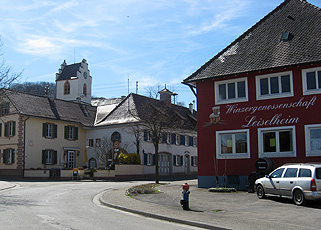
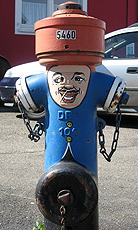
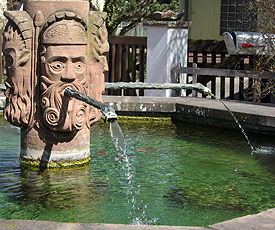
In Leiselheim: Dorfplatz/ Sie sorgen für Wasser: der personalisierte
Hydrant Nr 5460 und der ebenfalls personalisierte Stockbrunnen, einst
der einzige im Dorf
Der Ort Leiselheim ist ein verträumtes Dörfchen zwischen den Hügeln. Am zentralen Platz in der Ortsmitte steht - na was wohl - das Haus der örtlichen Winzergenossenschaft, ferner der Stockbrunnen und das ehemalige Schulhaus, das heute das Café "Lissele" beherbergt (pssst, nicht weitersagen: Dort gibt es himmlisch leckeren Kuchen!); nicht weit davon die Kirche mit ihrem Stufengiebel-Kirchturm. Wer etwas Muße und Wissbegierde mitbringt, kann sich auf informativen Tafeln kundig machen über die Dorfgeschichte: Wie lange dort schon (historisch belegt) Weinbau betrieben wird, wann zum erstenmal Schulkinder im Dorf unterrichtet wurden und dass die Quelle, die den Stockbrunnen speist, vermutlich der wahre Grund dafür ist, dass hier einst ein Ort entstand.

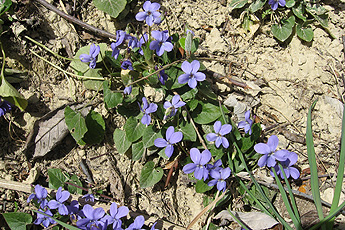

Frühlingswald mit Buschwindröschen und Veilchen/ Dieses Feldkreuz
steht in der Nähe von Kiechlinsbergen
Weiter geht's in Richtung Kiechlinsbergen. Der Boden des lichten Frühlingswalds ist bedeckt von Buschwindröschen, an den Wegrändern duften Veilchen. Mitten im Wald auf dem Höhenrücken "Langenberg" kreuzt mein Weg den Bienenfresserpfad, hinunter ins Tiefental verlaufen beide Wege gemeinsam, dann trennen sie sich wieder: der Bienenfresserpfad steuert Königschaffhausen in der Ebene an, ich besuche mit dem Kirschbaumpfad das Nachbardorf Kiechlinsbergen. Eine Infotafel erzählt die Geschichte eines Jahrhunderte dauernden Streits zwischen den beiden Dörfern, in dem es um die Nutzungsrechte an einer Quelle ging, die ziemlich genau auf der Gemarkungsgrenze zwischen den beiden Dörfern entsprang. Ein Ende machte dem Streit erst die moderne Wasserversorgung.

Kirschbaum, kurz vor der Blüte /Deborah und David
Kiechlinsbergen und Königschaffhausen sind "die" Kirschendörfer des Kaiserstuhls. Während anderswo Weinköniginnen und -prinzessinnen gekürt werden, wird in Königschaffhausen eine Kirschenkönigin und zwei -prinzessinnen gewählt und es gibt jedes Jahr ein Kirschenfest. - In Königschaffhauen gibt es auch ein Kirschenmuseum, das leider meist geschlossen hat.


2x Kiechlinsbergen , einmal davon noch mit den schneebedeckten Vogesen
am Horizont
Der Frühling ist in vollem Gange
Das schmucke Dorf Amoltern liegt verborgen zwischen Wald- und Rebhügeln in einem Tal am Ende einer Straße. Von hier aus werden während der Saison geführte Kräuterwanderungen angeboten und das hört sich verlockend an. Allein der Gedanke daran lässt würzige Düfte in der Gedankenwelt entstehen. Ich lege in Amoltern eine kleine Pause ein auf dem Dorfplatz neben dem stattlichen Fachwerkbau des Gasthauses zur Sonne, wo das Winzerdorf mit seinem Brunnen dem Weintrinkergott Bacchus ein Denkmal gesetzt hat.


In Amoltern: Dorfplatz mit dem Gasthof 'Sonne' / Winzerarbeit in alten
Zeiten zeigt eine Wand an der Winzergenossenschaft
Der Weg von Amoltern nach Endingen führt über die Amolterer Heide, eins der ersten Naturschutzgebiete im Kaiserstuhl, das wegen seiner vielen Orchideen bekannt ist. Doch jetzt ist es noch zu früh im Jahr für Orchideen. Das wird ein anderer Ausflug. Nach Endingen geht es weiter durch eine ziemlich beeindruckende Hohlgasse mit hohen Lösswänden rechts und links.
Als der Weg sich wieder öffnet, ist das malerische
Stadtchen nicht mehr fern. Hier sitzen schon alle draußen, um den Sonnenschein
und die Wärme zu genießen und das tue ich auch.
Ich gönne mir im Café am Marktplatz den ersten Eiskaffee der Saison und
fühle, wie meine Beine schwer und schwerer werden vom Wandern und vom
Sitzen. Eine wohlige Trägheit macht sich breit. Soll ich wirklich noch
bis Riegel weitergehen? Eigentlich könnte ich auch nach Hause fahren,
mich in die Hängematte auf dem Balkon legen und ganz gemütlich ein Buch
lesen.
Weil ich mich nicht entscheiden kann, beschließe ich, zum Bahnhof zu gehen und mal zu schauen, wann der nächste Zug nach Oberrotweil fährt. Sollte es bis dahin noch zu lange sein, dann kann ich ja noch nach Riegel weiter gehen. Doch der nächste fährt in 20 Minuten. Da siegt meine Faulheit und ich fahre nach Hause.

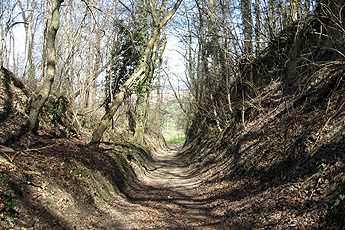
Ein prächtiger Hohlweg zwischen Amoltern und Endingen
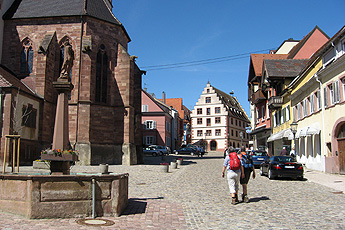

Sonntag im Frühling in Endingen: Nicht nur ich genieße das erste Eis
der Saison.
Oh, ich glaube, wenn ich wieder einmal den Kirschbaumpfad wandere, dann im Juni, wenn sie reif sind....mmmmmh
Plan your stay in Breisgau and Kaiserstuhl
The region of Breisgau offers a wide range of cultural and leisure facilities. Let me help you to establish a perfectly suiting sightseeing/ sports/ entertainment programme. For those who stay here for a language programme, just let me know your favourite field of interest and I can help get in contact with appropriate local leisure service providers
The following list is not finished yet. It will be completed by and by.
Culture
- Museums (Art), Galeries
Museum für Neue Kunst (Freiburg FR)
Augustinermuseum (FR)
Ausstellungen im Radbrunnenmuseum (Breisach BR)
Kunsthalle Messmer (Riegel)- Guided City tours
Stadt- und Münsterführung Freiburg-Kultour (FR)
Schwarzwaldmädel-Tour (FR)
Stadtführung per Fahrrad Freiburg-Aktiv (FR)
Stadtführung per Nordic Walking Freiburg-Aktiv (FR)
Stadt- und Münsterführung (BR)
Rundgang mit dem Burkheimer Nachtwächter (Vogtsburg-Burkheim Vo-Burkheim)- Casles, fortresses, churches
Freiburger Münster (FR)
Breisacher Münster (BR)
Hochkönigsburg (nr Selestat /Alsace)- Music
Klassikfest Kaiserstuhl (Ihringen Ihr)
Zelt-Musik-Festival (FR)
Konzerthaus Freiburg (FR)- Theatre
Wallgraben-Theater (FR)
Galli-Theater (FR)
Lux-Improvisations-Theater
Kleinkunstbühne Schloss Rimsingen
Festspiele (Freilichtbühne) (BR)- Movie
Diverse Kinos in Freiburg
Engel-Lichtspiele (BR)- Lectures
Volkshochschule (FR)
History
- Museums (historical)
Museum für Stadtgeschichte (FR)
Museum für Stadtgeschichte (BR)
Uhrenmuseum (Furtwangen)
Weinbaumuseum (Vo-Achkarren)
Korkenziehermuseum (Vo-Burkheim)
Elztalmuseum (Regionalgeschichte und Orgelbau (Waldkirch)
Vogtsbauernhöfe (Bauernhaus-Freilichtmuseum) (Gutach)- Guided City tours(historical)
Erlebnis-Touren Freiburg-Kultour (FR)
Event-Stadtführungen Historix-Tours (FR)- Craft, Technics
Glasbläserhof (Todtnau)
Schnitzerstube (Münstertal)
Museumsbergwerk Schauinsland
Kerzenwerkstatt (Vo-Oberbergen)
Breisacher Goldschmiede mit Esprit (BR)
Nature
- Hikes, walks, excursions
Schneeschuh-Wandertouren am Feldberg, am Belchen
Todtnauer Wasserfälle
Naturzentrum Kaiserstuhl (Geführte Wanderungen und Exkursionen)(Ihr)
Abend- und Mondscheinwanderungen G. Hess (Eichstetten)
Wanderungen auf den Schauinsland
Wanderung mit Weinprobe am Tuniberg (BR-Niederrimsingen)
Kulinarische Weinwanderung (Vo-Oberrotwei, 3. Sonntag im Junil)
Themenpfade im Kaiserstuhl- Cycle tours/ Radtouren / Bootstouren
Dschungel-Tour (geführte Rad- und Bootstour (FR-aktiv)
Bootsfahren im Taubergießen
Rhine River cruises (BR)- Flora/ Fauna
Schwarzwaldzoo (Waldkirch)
Samengarten (Eichstetten)- Gardens
Landhaus Ettenbühl (Bad Bellingen)
Staudengärtnerei Gräfin von Zeppelin (Sulzburg-Laufen)- Geology
- Astronomy
Sternwarte VHS March- Other amenities
Goldwaschen am Rhein (Neuenburg)
Angeln im Schwarzwald (Schluchsee, Titisee u.a.)
Park mit allen Sinnen (Gutach)- Lectures
Haus der Natur (Feldberg)
Naturzentrum Kaiserstuhl (Ihr)
Sports
- Winter sports
Ski / Snowboardschulen, Skilifte (Schauinsland, Feldberg, Belchen)
Loipen für Langläufer (Schauinsland, Feldberg, Belchen)
Rodeln
Schlittschuh / Eislaufen Eisbahnen (FR)
Natureisbahnen- Water sports
Public Pools (FR, Vo-Oberrotweil, BR)
Swimming lakes(Vo-Burkheim, Niederrimsingen)
Waldschwimmbad (BR)
Hallenbad/Sauna (BR)
Kanu / Kajak
Sailing/ Motor boat (Jachtschule MSO BR)
Water ski (Water ski club Breisgau Sasbach)
Diving (Diving school Bubble Duck BR)- Ball sports
Tennis (BR)
Socceer
Golf- Cycling
Mountainbiking (MB Fuhrpark Hasenhorn, Todtnau)
Fahrradverleih Funbike (BR)
Fahrradverleih Kaiserstuhl (Vo-Niederrotweil)
Geführte Tagestouren mit dem Rennrad (Breisgau-Radtouristik BR)- Climbing(Funsportcrew Matthias Hopp, Teningen)
- Runnung/Nordic Walking
Nordic Walking G. Hiss, Eichstetten)
Nordic Walking Kurse (BR)
Nordic Walking Parcours im südl. Rheinwald (BR)- Fun sports / Amusement parks
Europapark (Rust)
Hasenhorn Coaster/Rodelbahn (Todtnau)
Rodelbahn (Gutach)
Quadtouren (Rust)
Bergwelt Rolling / Rollerfahrt (Schauinsland)- Bowling
- Tai Chi / Qi Gong
Shan Shui Haus (Niederrimsingen)
Wellness, Spas
- Thermal spa
Eugen-Keidelbad (FR)
Vita classica (Bad Krozingen)
Cassiopeia-Therme (Badenweiler)- Natural pool and sauna
Wellness pur (March-Buchheim)
Eat, drink, relish
- Restaurants
- Wine tasting
Offener Winzerkeller (Vogtsburg/alle Teilorte)
Kulinarische Weinwanderung (Vo-Oberrotwei, 3. Sonntag im Junil)
Festival der Triebe (Vo-Achkarren)- Biergärten
- Seasonal taverns ("Straußenwirtschaften")
Special trips
Folk culture / Tradition
Shopping
Regional Economics
Creative activities
What's going on in....
Freiburg - Breisgau - Kaiserstuhl? (a selection)
Find information about events in Freiburg on the city’s website www.freiburg.de
To find what’s on in Breisach, visit the town’s website: www.breisach.de
There are several sites giving information about events in the Kaiserstuhl:
http://www.vogtsburg-im-kaiserstuhl.de
http://www.kaiserstuhl.cc
http://kaiserstuhl.net/index.htm
Museums in the Kaiserstuhl area
Vorderösterreich-Museum Endingen; Info Kaiserstühler Verkehrsbüro
07642-689990
Kaiserstühler Heimatmuseum Endingen/ Altes Rathaus; Info Kaiserstühler
Verkehrsbüro 07642-689990
Weinbaumuseum Achkarren; Info 07662-81243
Korkenzieher-Museum Burkheim; Info 0173-7001242
Käserei-Museum Endingen, Rempartstr. 7; Info07642-689990
Heimatmuseum Kiechlinsbergen, Grienerstr. 13; Info 07642-8220
Kirschenmuseum Königschaffhausen; Info 07642-8585
Archäologisches Museum Riegel; Info 07642-90440
In addition to special events, there are numerous regular town and city
guided tours, wine-tastings, excursions, talks … the list goes on and
on!
Want to know more about the Kaiserstuhl before you stay with us?
For those of you who like to do your homework before you go away on holiday,
I have written below a short geological history of the Kaiserstuhl and
a description of its fauna and flora, an explanation of PLENUM and an
account of a day spent on just one of the many hiking trails in the area.
Further information:
Landscape/ Scenery (photographs):
http://www.kaiserstuhl-breisgau.de/index.htm
Flora + fauna (photographs):
http://www.gabi-krumm.de/index.htm
Information about the region:
http://www.vogtsburg-im-kaiserstuhl.de
http://www.naturgarten-kaiserstuhl.de
http://kaiserstuhl.net/index.htm
Kaiserstuhl guest house, leisure facilities, learning and recreation, Kaiserstuhl geography, Kaiserstuhl origin, Kaiserstuhl hiking trails, Breisgau, Black Forest, River Rhine

 The Language Guesthouse/ Die Sprachpension - Bahnhofstr.5 - D-79235 Vogtsburg
im Kaiserstuhl - tel 0049-7662-936880
The Language Guesthouse/ Die Sprachpension - Bahnhofstr.5 - D-79235 Vogtsburg
im Kaiserstuhl - tel 0049-7662-936880 


